The term fishing may be applied to catching other aquatic animals such as molluscs, cephalopods, crustaceans, and echinoderms. The term is not normally applied to catching farmed fish, or to aquatic mammals, such as whales, where the term whaling is more appropriate.
According to FAO statistics, the total number of commercial fishermen and fish farmers is estimated to be 38 million. Fisheries and aquaculture provide direct and indirect employment to over 500 million people.[1] In 2005, the worldwide per capita consumption of fish captured from wild fisheries was 14.4 kilograms, with an additional 7.4 kilograms harvested from fish farms.[2] In addition to providing food, modern fishing is also a recreational pastime.
History
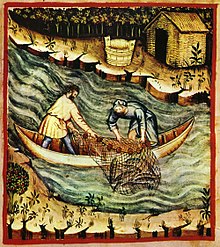
Fishing, tacuinum sanitatis casanatensis (14th century)
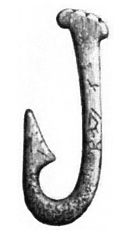
Stone Age fish hook made from bone
Main articles: History of fishing and History of seafood
Fishing is an ancient practice that dates back to at least the beginning of the Paleolithic period about 40,000 years ago.[3] Isotopic analysis of the skeletal remains of Tianyuan man, a 40,000 year old modern human from eastern Asia, has shown that he regularly consumed freshwater fish.[4][5] Archaeology features such as shell middens,[6] discarded fish bones and cave paintings
show that sea foods were important for survival and consumed in
significant quantities. During this period, most people lived a hunter-gatherer
lifestyle and were, of necessity, constantly on the move. However,
where there are early examples of permanent settlements (though not
necessarily permanently occupied) such as those at Lepenski Vir, they are almost always associated with fishing as a major source of food.The ancient river Nile was full of fish; fresh and dried fish were a staple food for much of the population.[7] The Egyptians had implements and methods for fishing and these are illustrated in tomb scenes, drawings, and papyrus documents. Some representations hint at fishing being pursued as a pastime. In India, the Pandyas, a classical Dravidian Tamil kingdom, were known for the pearl fishery as early as the 1st century BC. Their seaport Tuticorin was known for deep sea pearl fishing. The paravas, a Tamil caste centred in Tuticorin, developed a rich community because of their pearl trade, navigation knowledge and fisheries. Fishing scenes are rarely represented in ancient Greek culture, a reflection of the low social status of fishing. However, Oppian of Corycus, a Greek author wrote a major treatise on sea fishing, the Halieulica or Halieutika, composed between 177 and 180. This is the earliest such work to have survived to the modern day. Pictorial evidence of Roman fishing comes from mosaics.[8] The Roman god of the sea Neptune is depicted as wielding a fishing trident. The Moche people of ancient Peru depicted fishermen in their ceramics.[9]
One of the world’s longest trading histories is the trade of dry cod from the Lofoten area of Norway to the southern parts of Europe, Italy, Spain and Portugal. The trade in cod started during the Viking period or before, has been going on for more than 1,000 years and is still important.[citation needed]
Techniques
Main article: Fishing techniques
There are many fishing techniques or methods for catching fish. The term can also be applied to methods for catching other aquatic animals such as molluscs (shellfish, squid, octopus) and edible marine invertebrates.Fishing techniques include hand gathering, spearfishing, netting, angling and trapping. Recreational, commercial and artisanal fishers use different techniques, and also, sometimes, the same techniques. Recreational fishers fish for pleasure or sport, while commercial fishers fish for profit. Artisanal fishers use traditional, low-tech methods, for survival in third-world countries, and as a cultural heritage in other countries. Mostly, recreational fishers use angling methods and commercial fishers use netting methods.
There is an intricate link between various fishing techniques and knowledge about the fish and their behaviour including migration, foraging and habitat. The effective use of fishing techniques often depends on this additional knowledge.[10] Some fishermen follow fishing folklores which claim that fish feeding patterns are influenced by the position of the sun and the moon.
Tackle
Main article: Fishing tackle
Fishing tackle is a general term that refers to the equipment used by fishermen when fishing.Almost any equipment or gear used for fishing can be called fishing tackle. Some examples are hooks, lines, sinkers, floats, rods, reels, baits, lures, spears, nets, gaffs, traps, waders and tackle boxes.
Tackle that is attached to the end of a fishing line is called terminal tackle. This includes hooks, sinkers, floats, leaders, swivels, split rings and wire, snaps, beads, spoons, blades, spinners and clevises to attach spinner blades to fishing lures.
Fishing tackle can be contrasted with fishing techniques. Fishing tackle refers to the physical equipment that is used when fishing, whereas fishing techniques refers to the ways the tackle is used when fishing.
Fishing vessels
See also: Fishing vessels and Traditional fishing boats
A fishing vessel is a boat or ship used to catch fish in the sea, or on a lake or river. Many different kinds of vessels are used in commercial, artisanal and recreational fishing.According to the FAO, there are currently (2004) four million commercial fishing vessels.[11] About 1.3 million of these are decked vessels with enclosed areas. Nearly all of these decked vessels are mechanised, and 40,000 of them are over 100 tons. At the other extreme, two-thirds (1.8 million) of the undecked boats are traditional craft of various types, powered only by sail and oars.[11] These boats are used by artisan fishers.
It is difficult to estimate how many recreational fishing boats there are, although the number is high. The term is fluid, since most recreational boats are also used for fishing from time to time. Unlike most commercial fishing vessels, recreational fishing boats are often not dedicated just to fishing. Just about anything that will stay afloat can be called a recreational fishing boat, so long as a fisher periodically climbs aboard with the intent to catch a fish. Fish are caught for recreational purposes from boats which range from dugout canoes, kayaks, rafts, pontoon boats and small dingies to runabouts, cabin cruisers and cruising yachts to large, hi-tech and luxurious big game rigs.[12] Larger boats, purpose-built with recreational fishing in mind, usually have large, open cockpits at the stern, designed for convenient fishing.
Traditional fishing
Main article: Artisan fishing
Traditional fishing is a term used to describe small scale commercial or subsistence fishing practices, using traditional techniques such as rod and tackle, arrows and harpoons, throw nets and drag nets, etc.Recreational fishing
Main article: Recreational fishing
Recreational and sport fishing describe fishing primarily for pleasure or competition. Recreational fishing has conventions, rules, licensing restrictions and laws
that limit the way in which fish may be caught; typically, these
prohibit the use of nets and the catching of fish with hooks not in the mouth. The most common form of recreational fishing is done with a rod, reel, line, hooks and any one of a wide range of baits or lures such as artificial flies. The practice of catching or attempting to catch fish with a hook is generally known as angling. In angling, it is sometimes expected or required that fish be returned to the water (catch and release). Recreational or sport fishermen may log their catches or participate in fishing competitions.Big-game fishing describes fishing from boats to catch large open-water species such as tuna, sharks and marlin. Sport fishing (sometimes game fishing) describes recreational fishing where the primary reward is the challenge of finding and catching the fish rather than the culinary or financial value of the fish's flesh. Fish sought after include marlin, tuna, tarpon, sailfish, shark, mackerel, and many others.
Fishing industry
Main article: Fishing industry
The fishing industry includes any industry or activity concerned with
taking, culturing, processing, preserving, storing, transporting,
marketing or selling fish or fish products. It is defined by the FAO as including recreational, subsistence and commercial fishing, and the harvesting, processing, and marketing sectors.[13] The commercial activity is aimed at the delivery of fish and other seafood products for human consumption or for use as raw material in other industrial processes.There are three principal industry sectors:[Note 1]
- The commercial sector comprises enterprises and individuals associated with wild-catch or aquaculture resources and the various transformations of those resources into products for sale. It is also referred to as the "seafood industry", although non-food items such as pearls are included among its products.
- The traditional sector comprises enterprises and individuals associated with fisheries resources from which aboriginal people derive products in accordance with their traditions.
- The recreational sector comprises enterprises and individuals associated for the purpose of recreation, sport or sustenance with fisheries resources from which products are derived that are not for sale.
Commercial fishing
Main article: Commercial fishing
Commercial fishing is the capture of fish for commercial purposes.
Those who practice it must often pursue fish far into the ocean under
adverse conditions. Commercial fishermen harvest almost all aquatic
species, from tuna, cod and salmon to shrimp, krill, lobster, clams, squid and crab, in various fisheries for these species. Commercial fishing methods have become very efficient using large nets and sea-going processing factories. Individual fishing quotas and international treaties seek to control the species and quantities caught.A commercial fishing enterprise may vary from one man with a small boat with hand-casting nets or a few pot traps, to a huge fleet of trawlers processing tons of fish every day.
Commercial fishing gear includes weights, nets (e.g. purse seine), seine nets (e.g. beach seine), trawls (e.g. bottom trawl), dredges, hooks and line (e.g. long line and handline), lift nets, gillnets, entangling nets and traps.
According to the Food and Agriculture Organization of the United Nations, total world capture fisheries production in 2000 was 86 million tons (FAO 2002). The top producing countries were, in order, the People's Republic of China (excluding Hong Kong and Taiwan), Peru, Japan, the United States, Chile, Indonesia, Russia, India, Thailand, Norway and Iceland. Those countries accounted for more than half of the world's production; China alone accounted for a third of the world's production. Of that production, over 90% was marine and less than 10% was inland.

Intensive koi aquaculture facility in Israel
Fish farms
Main article: Fish farm
Fish farming is the principal form of aquaculture, while other methods may fall under mariculture.
It involves raising fish commercially in tanks or enclosures, usually
for food. A facility that releases juvenile fish into the wild for
recreational fishing or to supplement a species' natural numbers is
generally referred to as a fish hatchery. Fish species raised by fish farms include Atlantic salmon, carp, tilapia, catfish, trout and others.Increased demands on wild fisheries by commercial fishing has caused widespread overfishing. Fish farming offers an alternative solution to the increasing market demand for fish and fish protein.

Gyula Derkovits, still-life with fish (1928)
Fish products
Fish and fish products are consumed as food all over the world. With other seafoods, it provides the world's prime source of high-quality protein: 14–16 percent of the animal protein consumed worldwide. Over one billion people rely on fish as their primary source of animal protein.[15]Fish and other aquatic organisms are also processed into various food and non-food products, such as sharkskin leather, pigments made from the inky secretions of cuttlefish, isinglass used for the clarification of wine and beer, fish emulsion used as a fertilizer, fish glue, fish oil and fish meal.
Fish are also collected live for research or the aquarium trade.
Fish marketing
See also: Fish marketing and Fish markets
Fisheries management
Main articles: Fisheries management and Fisheries science
Fisheries management draws on fisheries science in order to find ways to protect fishery
resources so sustainable exploitation is possible. Modern fisheries
management is often referred to as a governmental system of (hopefully
appropriate) management rules based on defined objectives and a mix of
management means to implement the rules, which are put in place by a
system of monitoring control and surveillance.Fisheries science is the academic discipline of managing and understanding fisheries. It is a multidisciplinary science, which draws on the disciplines of oceanography, marine biology, marine conservation, ecology, population dynamics, economics and management in an attempt to provide an integrated picture of fisheries. In some cases new disciplines have emerged, such as bioeconomics.
Sustainability
Main article: Sustainable fishing
Issues involved in the long term sustainability of fishing include overfishing, by-catch, marine pollution, environmental effects of fishing, climate change and fish farming.Conservation issues are part of marine conservation, and are addressed in fisheries science programs. There is a growing gap between how many fish are available to be caught and humanity’s desire to catch them, a problem that gets worse as the world population grows.
Similar to other environmental issues, there can be conflict between the fishermen who depend on fishing for their livelihoods and fishery scientists who realise that if future fish populations are to be sustainable then some fisheries must limit fishing or cease operations.
Cultural impact
- Community impact: For communities like fishing villages, fisheries provide not only a source of food and work but also a community and cultural identity.[16]
- Semantic impact: The expression "fishing expedition" describes a situation where a questioner implies he knows more than he actually does in order to trick his target into divulging more information than he wishes to reveal. Other examples of fishing terms that carry a negative connotation are: "fishing for compliments", "to be fooled hook, line and sinker" (to be fooled beyond merely "taking the bait"), and the internet scam of Phishing in which a third party will duplicate a website where the user would put sensitive information (such as bank codes).
- Religious impact: Fishing has had an effect on all major religions, including Islam,[17] Christianity,[18][19] Buddhism, Jainism, Zoroastrianism, Hinduism, and the various new age[20] religions. According to the Roman Catholic faith the first Pope was a fisherman, the Apostle Peter,[21] a number of the miracles, and many parables and stories reported in the Bible involve it. The Pope's traditional vestments include a fish-shaped hat.
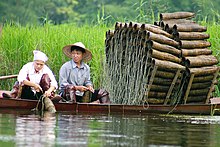
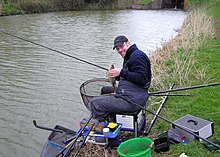


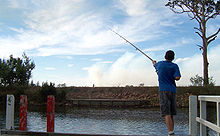

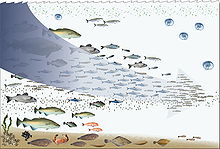
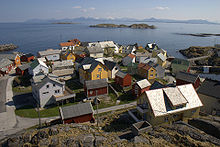
Tidak ada komentar:
Posting Komentar